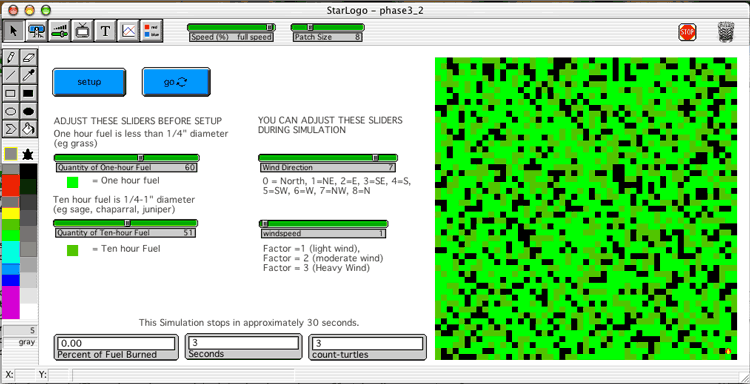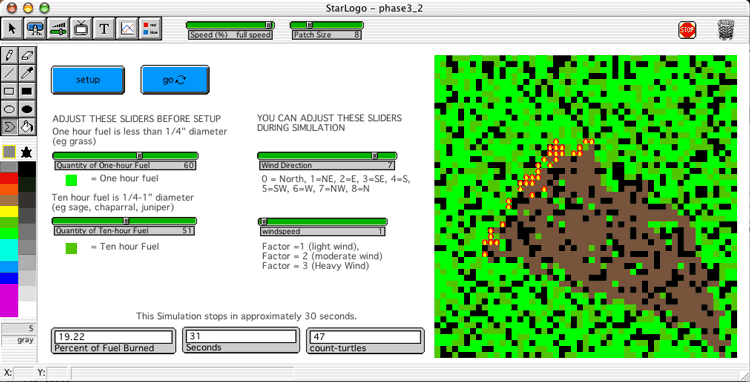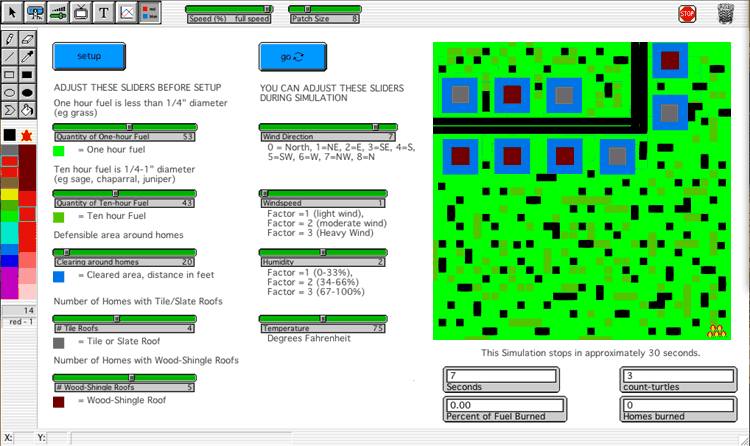|
|
Overview
"Unless we double our resources, this community is in danger of fires wreaking devastation of biblical proportions," states the head of your regional fire protection agency. Is this accurate? Or is she just lobbying for funds for the upcoming bond issue?
With the recent fires in California, we now understand that wildfires are a serious danger not only to forest and wildland areas but also to those residential and commercial areas perched near canyons and brushland. Recent reports indicate that the extensive fire and loss of property and life was predictable if serious fire broke out in those areas. But communicating the grave consequences of the events, in order to prepare the community to provide preventive resources is difficult without dynamic and effective tools.
We have developed a simulation, using StarLogo (a free agent modeling program from the MIT Media Lab) to show how wildfires spread and affect different types of property based on varying construction, environmental and topographical conditions. The simulation starts with an overview of a wildland area. By varying conditions such as vegetation, temperature, humidity, wind, time of day, etc., we intend to show how a wildfire is likely to spread. The simulation can be used to demonstrate fire-spread for a specific preset area and how changing the variables is likely to affect the spread. In future refinements and improvements to the model, it can show how buildings, homes and landscaping can be prepared to prevent damage from firespread.
Instructional Objective
Wildfire Challenge is a valuable communication tool for fire personnel, civilians and community leaders. It will allow personnel to communicate the fire danger and potential devastation that might occur during a spreading wildfire. It will also help them demonstrate to the public what they can do to mitigate damage in the future.
This need for fire safety communication was demonstrated just recently in the San Diego, California area where fires burned hundreds of thousands of acres of wildland; almost 3,000 homes were destroyed and at least 16 people died. The startling fact is that, in a report by the fire community the previous year, devastation was forecasted if a serious fire were to break out. Would the community have been more prepared if the fire professionals and community leaders had not only communicated this danger to but also demonstrated it in a model such as the one we have created?
We believe through use of an inexpensive and easy to operate tool such as our StarLogo model, communities and individuals can assess future danger and communicate the need for preparedness to avoid or minimize similar devastation.
Learners
Learners are citizens, community groups interested in understanding patterns of fire spread and fire danger, and fire personnel.
Civilian learners are primarily suburban homeowners of middle and upper income. Other parties might include building community leaders, contractors, urban planners, architects and others with a particular interest in protecting lives and property in the event of a wildfire.
In addition, this is a good training tool for fire personnel. They will learn patterns of burning and spreading wildland fires by observing fire patterns and rates of spread.
Context of Use
This model can be used and distributed in several ways:
- As a standalone program it can be distributed with additional support, reference and background material on a CD as part of a fire personnel training program.
- As a component on a fire safety web site that contains related material.
- As part of an interactive workshop facilitated by a fire or public safety official who runs the model based on input and feedback from the audience/participants.
- As a pre-set visual projected onto a larger screen as a communication and demonstration tool for a presentation about fire dangers.
The simulation can be used on the Internet or any recent model PC or Macintosh computer by individuals with basic computer knowledge. Because it has manipulable variables, it can be used once or many times for a few minutes or over an extended period.
In whatever way the participant uses the material, questions and associated discussion topics will be included to help learners recognize patterns forming to enable deeper understanding of how factors and forces affect wildfire spread and likelihood of damage. A presenter's guide will help facilitators practice communication techniques to explain effects and results to civilians and community leaders.
Scope
The simulation has a configuration as it stands now and also we propose additions for the future.
As it stands now, the simulation interface is a flat patch of wildland. The area contains sections of grass, sage and cleared (non-fuel) areas. The grass is designated as 1 hour fuel and is 1/4" or less in diameter. Sage is 10 hr fuel and is 1/4-1" in diameter. (The 1-hour, 10-hour designations refer to the moisture level of dead fuel. This is the time it takes the moisture in the fuel to equal the moisture level of the air around it.). The amount of each fuel can be changed by changing the variable setting (slider) for each. In addition the wind direction and intensity can be varied both during set up and during the simulation.
Future simulations will contain additional variables. These could include any of the following:
- A predetermined neighborhood bordering on the wildland area. The terrain remains fixed but the building and vegetation conditions can be varied to simulate how buildings of different construction and land management would manage when faced with an approaching fire.
- Building construction type (with particular focus on roofing material)
- The amount of defensible space around the home and the fuel covering the landscape (trees, underbrush, fallen brush, vegetation, etc.)
- Humidity and dryness factor (driven by the yearly rainfall)
- Barriers
Since conditions change over time and fire danger levels rise or fall with those conditions, users will set up the simulation and fix the variables. Taking note of the settings they will initiate the simulation and observe results. The simulation can be run on a set time basis and after the simulation the key observations will include how much of the area burned during the elapsed time and how does this compare to other conditions. Other observations may include: fire direction, rate of speed, direction of fire-spread, percentage of total area burned, and, most importantly, what areas experienced the least damage from the fire. By running the simulation several times with the same settings and then by varying the settings, users can establish an understanding of the fire's behavior and what critical conditions are associated with the most destruction. How these findings are addressed will depend on the manner in the specific concept to be learned or communicated and how the user presents the simulation.
Object of the Game
Whether presented by a facilitator or manipulated by an individual, the objective of this modeling exercise for fire personnel is to help members of a community better understand the dangers of wildfires, environmental conditions that may require special caution and factors that may be within their power to control and minimize damage. Learners will be able to demonstrate this understanding by summarizing at least three key observations about the modeling exercise.
In addition, when used as fire personnel training, this simulation is used to give users an understanding of how a fire spreads, especially with changing wind, fuel and weather conditions and how much time they have to act when conditions change. For example, when the wind increases and shifts, fire personnel must be able to act quickly to fight the fire or retreat. This simulation gives them a sense of the relative time they have to act in such situations.
Design Details
User Manipulable Variables
Prior to running the simulation, the user will input and be able to change the:
- Amount of fuel (brush, trees, and bushes) present across the surface of the burning area (Amount of 10 hr fuel and 1 hr fuel present.)
- Wind Speed
- Wind Direction
Output Variables
After running the simulation, output will show:
- Percent of area burned in the time set for the simulation
- Direction fire takes in relationship to wind direction
Default State of all Variables
Initial state of the variables will be the average states/values for input and output variables which are:
- Amount of fuel = 1 hr fuel is at 25% of capacity and 10 hr fuel is at 25% of capacity. Can be varied from 0 (simulates a burned or cleared state) up to 75%.
- Speed and direction of the wind = initial state is wind at 5mph but can be varied from 0 to 50 mph.
In the enhanced or future mode the site will have:
- Multiple homes with different types of construction material
- Clearance (defensible space) around homes = clearance around each home starts at 30 feet but can be varied from 5 to 100 feet
- Adjustments for humidity and temperature
See for Yourself - Simulation Download
You can download
the StarLogo simulation at:
WildfireChallenge (Version 1.0)
Click to Download
Requires StarLogo available as a free
download from the MIT
Media Lab.
The Look of the Simulation
These screen captures provide a glimpse of the action.
Starting Screen
Screen showing game in progress
Mathematical and Logical Relationships of Variables
Burn Ratio for two types of Fuel
The burn ratio One-hour and Ten-hour fuel approximately 1:2. That means
that the one hour fuel burns and moves faster but gains less energy
than the ten-hour fuel by 1/2.
Wind Speed
Wind speed can be adjusted by factors of 1, 2 or 3 which increases how
far a fire turtle can move forward on each turn.
Fire Spreads
Fire spreads or fire eventually dies out. While real fire behaves more
like a single entity than separate individual beings (like Star Logo
turtles), we were able to simulate this collectiveness by creating a
formula that allows for some fire to spread and stay alive while others
burned out.
As fireturtles gain energy by burning the two types of fuel the fireturtle
eventually reaches a certain energy level and "hatches" a new
fireshape. The two fireshapes then split their available energy which
allowed us to model the growing potential energy of a spreading fire.
In the case where the energy level drops below a certain level a procedure
instructs the fire shape to die out. Scenarios where fires lose energy
include encountering black (empty) or brown (burned) spaces or simply
moving forward a square.
Technical Elements
Authoring Software/Platform: The game is authored in StarLogo and can be played on a Mac or Windows computer. The player will need the StarLogo program for their OS loaded onto their system but this is a free download from the MIT Media Lab. The data file is readable by either a Mac or Windows platform. The software will run on a relatively basic computer with minimal 640x480/256-color video configuration.
StarLogo works cross platform. The files are .slogo files which are readable by either a Mac or Windows platform. Graphics are included within the .slogo file and the program does not support sound.
Competing and Related Products
Simulation software:
iThink and Stella: http://www.hps-inc.com/
Model-It: http://goknow.com/Products/Model-It/
These are business modeling software packages and competitive in that
they can be programmed for to run simulations of systems other than independent
multi-agent systems like StarLogo.
Fire simulation software:
BehavePlus2: Funded by the USDA and USFS, this is quite a package. Its development involved many people. We could not possibly emulate this without major funding!!! And lots of time.
FARSITE: This program is widely used by the USDI National Park Service, USDA Forest Service, and other federal and state land management agencies to simulate the spread of wildfires and fire use for resource benefit across the landscape. It is designed for use by users familiar with fuels, weather, topography, wildfire situations and the associated terminology. Because of its complexity, only users with the proper fire behavior training and experience should use FARSITE where the outputs are to be used for making fire and land management decisions.
Fusebox: This is a very simple, but effective simulation. It appears to be programmed in StarLogo but the object of the game is to burn down the forest by manipulating campfires and the density of the trees in the forest. It's the opposite of what we were trying to communicate.
Other
Firewise: This is not a competing product, but it contains lots of interesting interactive content.
Motivational Issues
Though relatively simple at this point, Wildfire Challenge can engage learners on several levels. In the context of Keller's ARCS Model the simulation gets viewers' attention because of its relevance to recent tragic events. By demonstrating some aspects of wildfire characteristics in a non-threatening environment, learners can develop confidence in their ability to control their real-world environment to achieve a level of satisfaction without endangering their personal safety. Clearly, residents of a tropical isle or a Manhattan hi-rise co-op would not be very motivated to interact with this simulation.
On a lesser scale, Wildfire Challenge does have some characteristics along the lines of Lepper & Malone's Taxonomy of Intrinsic Motivations. The simulation provides a bit of a challenge to determine what it takes to either burn the maximum area (especially appealing for sociopaths) or minimize the spread of the fire. It also satisfies some level of curiosity about how fire spreads and why the same spark can become a raging inferno one day and simply fizzle out at another time or in another place. This curiosity is further stimulated by the ability to manipulate some environmental factors, giving the learner a level of control over the scenario.
Design Process
This simulation started as a result of the recent (2003) fires in San Diego County. Many people were unprepared for the speed of the fire's spread and the resulting extensive destruction. We began our project believing that a tool that would help simulate a wildfire would be beneficial to predict its path and educate firefighters in how to defend against it.
As we searched we discovered there has been considerable research on fire, its spread and how a fire moves through a wildland area. We interviewed wildland firefighting book authors, experts and National Forest Fire Managers and learned there have been several wildfire models developed to predict a fires spread. Two key areas that have not been pursued in such simulations were: (1) The aspects of a home that borders a fire will make it survivable, and (2) a tool to help firefighting personnel easily communicate a fire's spread to civilians. We then directed our efforts to determine if we could create a simulation that would address one or both of these issues. At the same time we wanted to develop a tool to help firefighting personnel see the path a fire would take under different conditions and learn how to make better decisions under changing fire conditions.
We selected the StarLogo simulation tool since it was a good tool to model decentralized agent behavior. We then started to investigate the factors that determine fire spread across a wildland area, and especially those that give it direction, speed, and release of energy (heat intensity). In addition, we researched home construction and area design factors that would provide survivability for homes in close proximity to a fire area.
We listed the major factors that were important for a fire simulation. As we learned StarLogo and its capabilities we started to rank the factors to determine which we could reasonably expect to include in our simulation. Our StarLogo expert then started to develop landscapes that simulated wildland areas and create agents (fire) that would spread according to relationships programmed into the simulation language. We started with simple, basic elements of landscape and fire movement and as these began to work we started to add additional elements into the simulation.
As we developed the simulation we decided which variables we could include in our simulation that would: (1) simulate reality and (2) allow us to meet our deadlines. We finalized these decisions with the following variables. Users can vary:
- The amount of fuel (1hr and 10 hr fuel) on the ground. This is realistic because the amount changes based on how much has been cleared, how many years have passed since the last fire, has it been a dry or wet year, etc.
- The direction and intensity of the wind. The wind changes and it's important to understand how fast it will move, especially if it changes direction and firefighters are in its path.
Future development will place houses (with different burn factors) on the periphery or in the path of the fire, allow changes in humidity and moisture present, enable changes in the slope and shape of the ground and permit changes in the temperature and time of day. The rendering below shows how a starting screen might look with these additional variables and factors.
Concept for Added Simulation Features

References
- Colella, V., Klopfer, E. & Resnick, M. (2001) Adventures in modeling: Exploring complex, dynamic systems with StarLogo. New York, New York: Teachers College Press.
- Keller, J.M. & Suzuki, K. Use of the ARCS motivation model in courseware design.
- Malone, T.W. & Lepper, M.R. Making learning fun: A taxonomy of intrinsic motivations for learning.
- Teie, W.C. (2001). Firefighter's handbook on wildland firefighting: Strategy, tactics and safety. Rescue, CA. Deer Valley Press
Electronic
- Star Logo:
http://education.mit.edu/starlogo/ - Brushfires explained:
http://clearlyexplained.com/nature/earth/disasters/bushfires.html - US Forest Service information site with rate of spread of fire factors http://edis.ifas.ufl.edu/BODY_FR138
- Fire education and prevention:
http://www.firewise.org/www/default2.htm - Wildland fire factors:
http://lamar.colostate.edu/~csfsbo/winiger/zones.htm - Defensible fire zones: http://www.cahe.nmsu.edu:16080/defensible_zone/protect/zone.html
- Fire model with diagrams: http://gis.esri.com/library/userconf/proc02/pap0285/p0285.htm
- Wildfire spread factors:
http://216.239.41.104/search?q=cache:kTwf3P-6TVsJ:www.forestry.ky.gov/pdf/fireweather.pdf+factors+that+affect+a+wildfire&hl=en&ie=UTF-8 - Fire spread and home protection:
http://216.239.41.104/search?q=cache:rRxe3h-WShAJ:www.glffc.com/public/acrobat/Wildfire.pdf+factors+that+affect+a+wildfire&hl=en&ie=UTF-8
Subject Matter and Programming Experts
- Tim McNerney, StarLogo Advisor
- Phillip Riggan, US Forestry Service, Director Cleveland National Forest
- William Teie, California Department of Forestry and Fire Protection, retired.
Last updated Monday, December 15, 2003 8:02 AM
